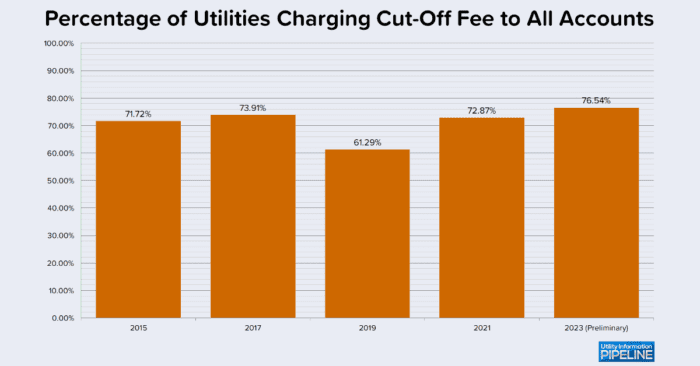When I present my most popular presentation at utility conferences, there are two takeaways I want all participants to leave with. These are (a) charge an application fee, and (b) charge the cut-off fee to all accounts when the cut-off list leaves the office.
In the last blog post, I wrote about application fees based on the preliminary results of the 2023 Utility Fee Survey. This week, I want to look at the trend of charging the cut-off fee to all accounts as soon as the cut-off list leaves the office.
Before we do that, let me pause for a minute and ask if you’ve participated in the 2023 Utility Fee Survey? If not, would you please take a minute to complete the survey now?
As you can see from the graph above, this year the percentage of utilities following the best practice of charging the cut-off fee to all accounts is the highest it has ever been. However, nearly a quarter of the responding utilities still aren’t doing it. Why is that…?
Why should you do this?
Outlined below are some of the compelling reasons why you should charge the cut-off fee to all accounts as soon as the list leaves your office.
More revenue for your utility
Quite simply, assessing the fee to all accounts at once generates more revenue for your utility. Customers who pay before their service is disconnected no longer get to avoid paying the fee.
More equitable to your customers
Is it really fair to your customers who live closest to your office (and therefore get cut-off first) to always pay the fee while those who live farther away get the benefits of a few extra hours to pay before being charged the fee?
Less confusion for cashiers
By assessing the cut-off fee to all accounts at once, your cashiers no longer have to contact the field service technicians to see if an account has been disconnected and should be charged the fee. The fee will already be part of the customer’s account balance when they pay.
It’s more efficient
Charging the fee to accounts individually means you can’t take advantage of your billing software to apply the fee automatically. Also, by charging it to everyone on the cut-off list, you don’t have to worry about customers who pay online and avoid paying the cut-off fee, because it’s already been added to their account.
Allows field staff to focus on disconnects
Since your field staff will no longer be interrupted periodically by cashiers to see if an account has been cut off, they can focus on what they need to do. Which, of course, is disconnect accounts as quickly as possible so they can start reconnecting customers as they pay.
Don’t forget to change what you call your cut-off fee
Finally, once you make the change, be sure to call your fee something other than cut-off or reconnect fee. Inevitably, you will have customers challenge you that, since they weren’t cut off, you can’t charge them a cut-off or reconnect fee.
A number of utilities have come up with creative names for their fee such as Non-Payment Fee, Delinquent Fee, and Administrative Fee. You can see a complete chart of terminology in the results of the 2021 Utility Fee Survey.
Utility Billing Mailbag
Don’t forget the new feature I’m calling the Utility Billing Mailbag. Send me your questions and I’ll take my best shot at answering them.
You can ask your questions at the Mailbag page on my website and I’ll post the answers on my social media. So be sure to follow me on Facebook, LinkedIn, or Twitter.
Complete the 2023 Utility Fee Survey
If you haven’t already completed the 2023 Utility Fee Survey, and would like to, please click here to complete the survey. It should take less than five minutes to complete.
If you have any questions, please feel free to e-mail me at gary@utilityinformationpipeline.com or call me at 919-673-4050.
Thank you in advance for your participation in the 2023 Utility Fee Survey.
Are there other best practices you aren’t following?
Is your utility following all the best practices? If you’re not sure, please give me a call at 919-673-4050 or email me at gary@utilityinformationpipeline.com to learn how a business review could help you find out.
